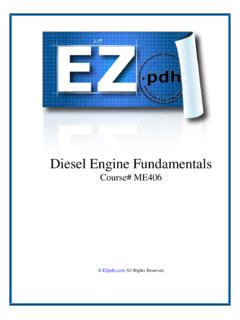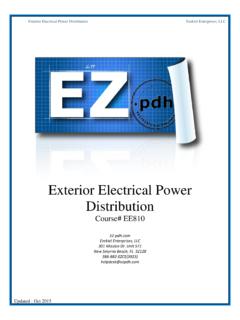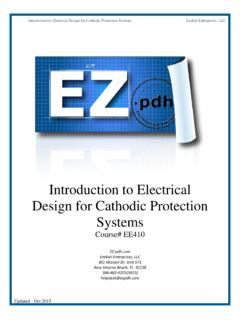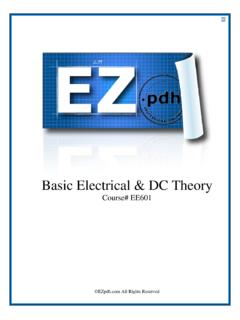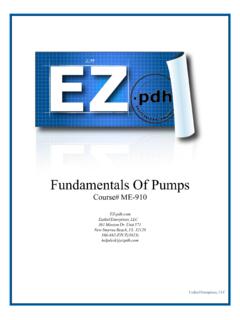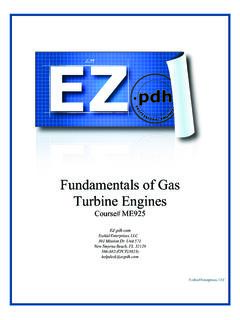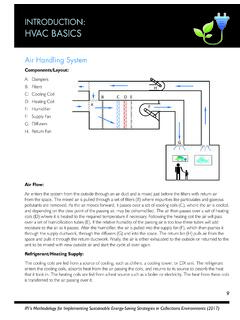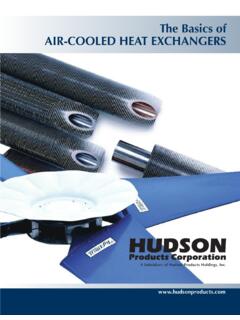Transcription of Heat Exchanger Fundamentals
1 heat Exchanger Fundamentals Course# ME905 Ezekiel Enterprises, LLC 301 Mission Dr. Unit 571 New Smyrna Beach, FL 32128 386-882-EZCE(3923) Ezekiel Enterprises, LLC DOE-HDBK-1018/1-93 JANUARY 1993 DOE Fundamentals HANDBOOKMECHANICAL SCIENCEV olume 1 of Department of EnergyFSC-6910 Washington, 20585 Distribution Statement A. Approved for public release; distribution is document has been reproduced directly from the best available to DOE and DOE contractors from the Office of Scientific andTechnical Information. Box 62, Oak Ridge, TN to the public from the National Technical Information Services, of Commerce, 5285 Port Royal., Springfield, VA No. DE93012178 Department of EnergyFundamentals HandbookMECHANICAL SCIENCEM odule 2 heat ExchangersHeat ExchangersDOE-HDBK-1018/1-93 TABLE OF CONTENTSTABLE OF CONTENTSLIST OF iiLIST OF vTYPES OF heat 1 Types of heat Exchanger 2 Types of heat 4 Comparison of the Types of heat 11 heat Exchanger 13 Air Conditioner Evaporator and 14 Large Steam System 18 Rev.
2 0 Page iME-02 LIST OF FIGURESDOE-HDBK-1018/1-93 heat ExchangersLIST OF FIGURESF igure 1 Tube and Shell heat 3 Figure 2 Plate heat 4 Figure 3 Parallel Flow heat 5 Figure 4 Counter Flow heat 5 Figure 5 Cross Flow heat 6 Figure 6 Single and Multi-Pass heat 9 Figure 7 Regenerative and Non-Regenerative heat 10 Figure 8 U-tube Feedwater heat 13 Figure 9 Single Pass 15 Figure 10 Jet 16ME-02 Page iiRev. 0 heat ExchangersDOE-HDBK-1018/1-93 LIST OF TABLESLIST OF TABLES NONERev. 0 Page iiiME-02 REFERENCESDOE-HDBK-1018/1-93 heat ExchangersREFERENCES Babcock & Wilcox, Steam, Its Generations and Use, Babcock & Wilcox Co. Cheremisinoff, N. P., Fluid Flow, Pumps, Pipes and Channels, Ann Arbor Science. heat Transfer, Thermodynamics and Fluid Flow Fundamentals , Columbia, MD,General Physics Corporation, Library of Congress Card #A 326517.
3 Marley, Cooling Tower Fundamentals and Applications, The Marley ivRev. 0 heat ExchangersDOE-HDBK-1018/1-93 OBJECTIVESTERMINAL references, DESCRIBE the purpose, construction, and principles of operation foreach major type of heat Exchanger : parallel flow, counter flow, and cross the two types of heat Exchanger with a drawing of a heat Exchanger , IDENTIFY the following internal hot and cold fluid flow in parallel flow, counter flow, and cross flow between the following types of heat versus multi-pass heat versus non-regenerative heat at least three applications of heat the purpose of a the following why condensers in large steam cycles are operated at a 0 Page vME-02 OBJECTIVESDOE-HDBK-1018/1-93 heat ExchangersIntentionally Left BlankME-02 Page viRev.
4 0 heat ExchangersDOE-HDBK-1018/1-93 TYPES OF heat EXCHANGERSTYPES OF heat EXCHANGERSIn almost any nuclear, chemical, or mechanical system, heat must be transferredfrom one place to another or from one fluid to another. heat exchangers are usedto transfer heat from one fluid to another. A basic understanding of themechanical components of a heat Exchanger is important to understanding howthey function and the two types of heat Exchanger with a drawing of a heat Exchanger , IDENTIFY thefollowing internal hot and cold fluid flow in parallel flow, counterflow, and cross flow heat between the following types of heat versus multi-pass heat versus non-regenerative heat exchangersIntroductionA heat Exchanger is a component that allows the transfer of heat from one fluid (liquid or gas)to another fluid.
5 Reasons for heat transfer include the heat a cooler fluid by means of a hotter reduce the temperature of a hot fluid by means of a cooler boil a liquid by means of a hotter condense a gaseous fluid by means of a cooler boil a liquid while condensing a hotter gaseous fluidRegardless of the function the heat Exchanger fulfills, in order to transfer heat the fluids involvedmust be at different temperatures and they must come into thermal contact. heat can flow onlyfrom the hotter to the cooler 0ME-02 Page 1 TYPES OF heat EXCHANGERSDOE-HDBK-1018/1-93 heat ExchangersIn a heat Exchanger there is no direct contact between the two fluids. The heat is transferredfrom the hot fluid to the metal isolating the two fluids and then to the cooler of heat Exchanger ConstructionAlthough heat exchangers come in every shape and size imaginable, the construction of most heatexchangers fall into one of two categories: tube and shell, or plate.
6 As in all mechanical devices,each type has its advantages and and ShellThe most basic and the most common type of heat Exchanger construction is the tube andshell, as shown in Figure 1. This type of heat Exchanger consists of a set of tubes in acontainer called a shell. The fluid flowing inside the tubes is called the tube side fluidand the fluid flowing on the outside of the tubes is the shell side fluid. At the ends ofthe tubes, the tube side fluid is separated from the shell side fluid by the tube sheet(s).The tubes are rolled and press-fitted or welded into the tube sheet to provide a leak tightseal. In systems where the two fluids are at vastly different pressures, the higher pressurefluid is typically directed through the tubes and the lower pressure fluid is circulated onthe shell side.
7 This is due to economy, because the heat Exchanger tubes can be madeto withstand higher pressures than the shell of the heat Exchanger for a much lower support plates shown on Figure 1 also act as baffles to direct the flow of fluid withinthe shell back and forth across the 0 Page 2 heat ExchangersDOE-HDBK-1018/1-93 TYPES OF heat EXCHANGERSP lateFigure 1 Tube and Shell heat ExchangerA plate type heat Exchanger , as illustrated in Figure 2, consists of plates instead of tubesto separate the hot and cold fluids. The hot and cold fluids alternate between each of theplates. Baffles direct the flow of fluid between plates. Because each of the plates hasa very large surface area, the plates provide each of the fluids with an extremely largeheat transfer area. Therefore a plate type heat Exchanger , as compared to a similarlysized tube and shell heat Exchanger , is capable of transferring much more heat .
8 This isdue to the larger area the plates provide over tubes. Due to the high heat transferefficiency of the plates, plate type heat exchangers are usually very small when comparedto a tube and shell type heat Exchanger with the same heat transfer capacity. Plate typeheat exchangers are not widely used because of the inability to reliably seal the largegaskets between each of the plates. Because of this problem, plate type heat exchangershave only been used in small, low pressure applications such as on oil coolers forengines. However, new improvements in gasket design and overall heat exchangerdesign have allowed some large scale applications of the plate type heat Exchanger . Asolder facilities are upgraded or newly designed facilities are built, large plate type heatexchangers are replacing tube and shell heat exchangers and becoming more common .
9 Rev. 0ME-02 Page 3 TYPES OF heat EXCHANGERSDOE-HDBK-1018/1-93 heat ExchangersTypes of heat ExchangersFigure 2 Plate heat ExchangerBecause heat exchangers come in so many shapes, sizes, makes, and models, they are categorizedaccording to common characteristics. One common characteristic that can be used to categorizethem is the direction of flow the two fluids have relative to each other. The three categories areparallel flow, counter flow and cross flow, as illustrated in Figure 3, exists when both the tube side fluid and the shellside fluid flow in the same direction. In this case, the two fluids enter the heatexchanger from the same end with a large temperature difference. As the fluids transferheat, hotter to cooler, the temperatures of the two fluids approach each other. Note thatthe hottest cold-fluid temperature is always less than the coldest hot-fluid 0 Page 4 heat ExchangersDOE-HDBK-1018/1-93 TYPES OF heat EXCHANGERSF igure 3 Parallel Flow heat ExchangerCounter flow, as illustrated in Figure 4, exists when the two fluids flow in oppositedirections.
10 Each of the fluids enters the heat Exchanger at opposite ends. Because thecooler fluid exits the counter flow heat Exchanger at the end where the hot fluid entersthe heat Exchanger , the cooler fluid will approach the inlet temperature of the hot flow heat exchangers are the most efficient of the three types. In contrast to theparallel flow heat Exchanger , the counter flow heat Exchanger can have the hottest cold-fluid temperature greater than the coldest hot-fluid 4 Counter Flow heat ExchangeRev. 0ME-02 Page 5 TYPES OF heat EXCHANGERSDOE-HDBK-1018/1-93 heat ExchangersCross flow, as illustrated in Figure 5, exists when one fluid flows perpendicular to thesecond fluid; that is, one fluid flows through tubes and the second fluid passes around thetubes at 90 angle. Cross flow heat exchangers are usually found in applications whereone of the fluids changes state (2-phase flow).
